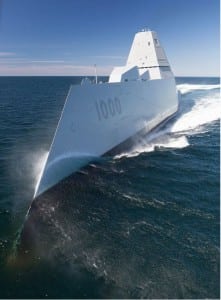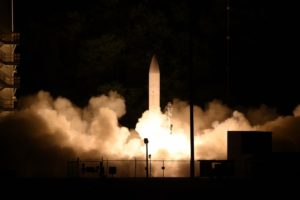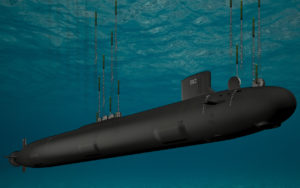A top Navy official said last week the service is confident they will field hypersonic weapons on both a Zumwalt-class destroyer and Virginia-class submarine later this decade despite time pressures.
“I think we’re on a pretty good path right now, time is not our friend, to be honest with you. I think that’s the biggest thing we’re [pressured on],” Vice Adm. Johnny Wolfe, the Navy’s director for Strategic Systems Programs, said during the annual Naval Submarine League symposium on Nov. 1.

The Navy has planned to field hypersonic weapons, called the Conventional Prompt Strike (CPS), on a Zumwalt-class destroyer (DDG-1000) by 2025, and the first Virginia-class submarine equipped with the Virginia Payload Module (VPM) by 2029.
The Navy is working with the Army on the same all-up round for the latter to have its initial deployment in 2023 in a truck-launched form.
Wolfe said the biggest challenge is getting through all-up round integration, but that DoD has proven the technology for the warhead and rocket motor stacks.
“Now we got to get the final integration and prove that we can actually start producing those reliably and at scale, as we move forward.”
He said the main issue for the DDG-1000 integration is the timeline to 2025.
“That’s three years from now. We’ve got to get on with getting all of the design for the Zumwalt, getting all of those tubes in there…to put these large diameter tubes in there, and then finish the integration work into the combat system that that class is going to have on board so that so that we can get to where we need to get. So I think that’s the real challenge.”
Wolfe told reporters on the sidelines of the conference that DoD has started to do in-air launch testing, which is one of the main differences with the Army hot launch method, via a Transporter Erector Launcher (TEL).
“We can’t do that on Navy platforms because of the heat. So our first challenge was, can we develop an in-air launch, basically pressurized air to get that weapon out of a Zumwalt, up in the air, so it lights off, and we don’t have all those hot gasses. We’ve actually proven that, we’ve done that testing. And so we’ve proven we can get to the air launched portion of this.”
Wolfe also noted the Navy will remove the Zumwalt’s unused Advanced Gun System mounts during a modernization period in 2025 and replace them with four 87-inch large diameter tubes.
“It will look just like we’ve going to have on the Virginia Payload Module. It looks like what we got on [Ohio-class submarines converted from fielding nuclear missiles to conventional guided missiles, SSGNs]. And then inside of that, we have what we call an advanced payload module. And that is an adapter that fits down inside of there, that will allow us to have multiple rounds in each one of those four tubes.”
He confirmed all the integration is planned for 2025 and the Navy will conduct two to three test shots by the end of 2025.

Wolfe said the Zumwalt-class work will be finished by the end rather than earlier in 2025 “because again, it’s all about schedule. We understand what the payload tubes look like. We understand all those, we’re building those for what we’re going to put on Virginia, and what we’re going to put onto Zumwalt. So it’s just schedule that we’re fighting with right now.”
The Navy’s fiscal year 2022 budget request disclosed the service’s plans to replace the three Zumwalt-class destroyers’ guns with up to 12 hypersonic weapons each (Defense Daily, June 8, 2021).
Wolfe also argued during his presentation that while the Virginia-class integration in 2029 seems a long time at seven years if they stay on schedule, the Navy has already reduced a lot of risk.
He said while the in-air launch testing for the hypersonic weapon applies to submarine integration once it rises out of the surface, it also requires underwater launch testing.
“We’re starting to build the facility to do underwater launch testing, so that we understand what that weapon will do, even before we get to the first Virginia. And then I do think, it’s going to be getting the platform ready to go with the Virginia Payload Module and getting that integration of weapon to combat system to platform done for us to get there.”
Wolfe told reporters the underwater launch testing facility is under construction in Crane, Ind.
“So you got to get the pit, you got to get the tank, all of that it’s got to get done. And then really, from there, it becomes an understanding of as you push this weapon through the water, understanding what the hydrodynamics are, understanding how it interacts, the launcher system that we’re going to use to get it out. That’s all part of this.”

He underscored that while the underwater launch testing is a challenge, “it’s not something particularly we don’t understand because in the Trident program, that’s exactly what we’ve done since the very beginning…understanding the underwater dynamics, understanding how you get all that done. We do it with Tomahawk on SSGN. So that’s why we know it’s a challenge, but we believe we’ve got all the capabilities to actually go after that.”
Separately, he argued the Navy is “very well on our way” on combat system integration on both platforms.
Wolfe said DoD is “very well on our way” for the software needed for combat system integration, since the Army needs it first for initial operating capability in 2023.
The software will be “almost the same for what the Army is going to build on their TEL with their combat system, what we’ll build on Zumwalt with her combat system, and what we’ll ultimately field on Virginia class.”
He noted one of the hypersonic tests coming up in 2023 will include the combat system that will deploy with the Army, so that helps the Navy’s progress as well.
General Dynamics’ Bath Iron Works [GD] built the three Zumwalt-class destroyers while GD Electric Boat and HII’s Newport News Shipbuilding [HII] are making the first Block V Virginia-class submarines equipped with the VPM.